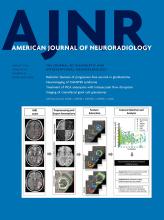We found the article by Prodi et al1 on the usefulness of a multimodal CT protocol in the diagnosis of stroke mimics very interesting. Among the pathologies evaluated is the so-called “conversive disorder,” a disorder in which diagnostic imaging was not useful.
The nosologic term “conversive disorder” should be abandoned, and instead the term “functional neurologic disorder” (FND) should be used. Recent research has made it clear that FND is not a rule-out diagnosis but a rule-in diagnosis based on positive physical examination findings.2 The term conversive disorder implies a psychiatric disease and leads the treating physician to think that there is no structural brain alteration; therefore, there should be no alteration in the diagnostic images. In recent years, it has been established that these patients do have subtle alterations on MR imaging,3⇓-5 such as smaller volume of the thalamus,5 an increased cortical thickening in the premotor cortex,3 and an inverse association between somatoform dissociation and left caudal anterior cingulate cortical thickness.4
The emergence of FND as a brain disease with an organic substrate and probable structural alterations should lead us to change the paradigm of the mental-versus-organic dichotomy.
Footnotes
Disclosure forms provided by the authors are available with the full text and PDF of this article at www.ajnr.org.
References
- © 2022 by American Journal of Neuroradiology












